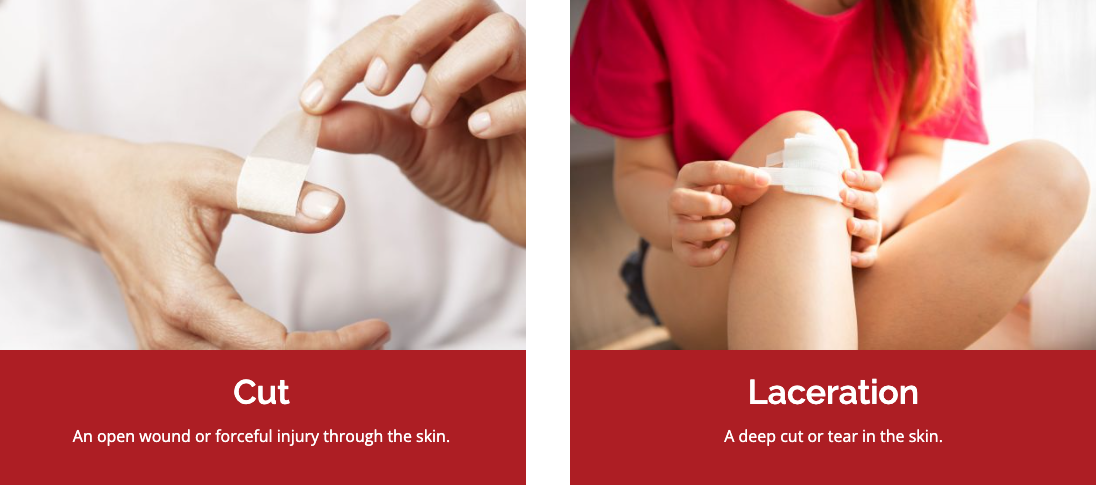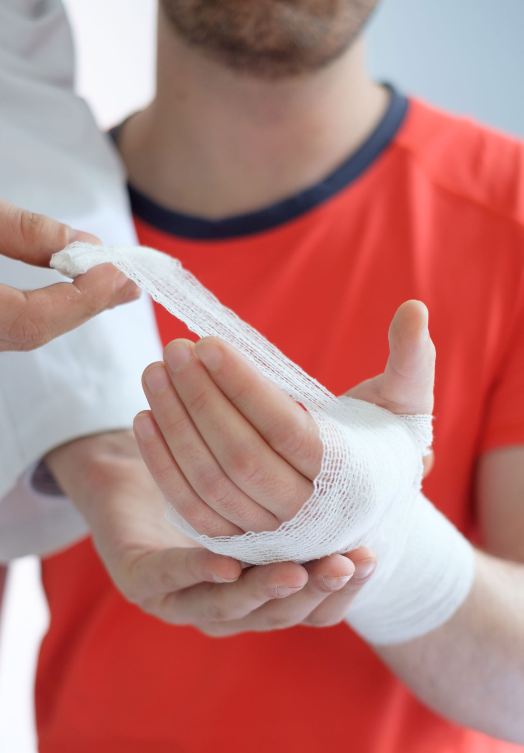
Wounds & Lacerations
Bleeding, Cuts, Wounds, & Lacerations

What to Do for Any Cut
Apply first aid.
Most cuts are minor and respond well to home treatment. Apply first aid
wearing medical gloves when possible. If medical gloves are not available
and you must apply pressure, place something between your hands and the
wound — multiple layers of clean cloth, plastic bags, or the cleanest
material available.
Try to stop the bleeding.
- Use steady, direct pressure for at least 15 minutes – time it and do not stop pressure to look at the wound.
- If the material becomes soaked, place more material on top, do not stop pressure.
- Elevate the cut above the heart if possible.
- If there is something in the wound, apply pressure on either side, not on top of the object.
Once the bleeding stops:
- Gently clean the wound with tap water and dilute antibacterial soap. Do not apply hydrogen peroxide as this could damage the tissues.
- Apply antibiotic ointment and a bandage.
- Re-apply the ointment and a new bandage several times a day.
Monitor.
Monitor the wound and call your healthcare professional if you become concerned.
 When to Get Emergency Medical Treatment
When to Get Emergency Medical Treatment
Types of wounds requiring a visit to the ER and may need stitches:
- Visible dermis or yellow layer of fatty tissue (subcutaneous tissue) or wounds over a possible broken bone.
- Tip of finger or toe cut off.
- Split or gaping open so gentle pressure can’t keep the edges together.
- Foreign object sticking through the skin. Do NOT remove any foreign object.
- Bites, human or animal.*
- A high-pressure impact wound from a bullet or other projectile.
- A cut over a joint – possible damage to nerves, ligaments, or tendons.
- Contaminated by a dirty or rusty object.*
- Severe, profuse, or copious bleeding.
- On or near the genitalia.
- On the face or another area where you want to minimize the scarring.
- Wounds that appear big enough for Steri-StripsTM
*Steri-StripTM is a registered trademark of 3M.
*Human and animal bites and injuries from rusty or dirty objects may require a tetanus shot and antibiotics along with stitches.
CAUTION: If there is severe swelling or bruising beginning within 30 minutes of an injury, it could signal serious bleeding or damage to the deep tissues.
TIP: If you believe a child may require stitches, withhold food and drink before going to the emergency room. The child may need to be sedated, and eating and drinking can delay treatment.
What Causes Cuts, Lacerations, Wounds, & Bleeding?
Most cuts are accidental. People working with household or yard tools, or operating machinery may become injured. Children get cut during play or from falls while riding wheeled toys.
Blunt objects tearing or crushing skin, commonly over bony areas like a finger, hand, foot, or knee.
- Tears and crush injuries can occur on any part of the body.
- Blunt object injuries usually cause swelling and tissue damage.
- They leave ragged wound edges that can cause healing problems.
Sharp-edged objects pressing into, piercing, and slicing the skin causing incised or puncture wounds.
- Sharp tools and items cause deeper cuts and damage underlying tissue.
Blunt and sharp objects combined tearing, slicing, and crushing the skin and underlying tissue.
Don’t hesitate to call your primary healthcare provider if you have any concerns.
